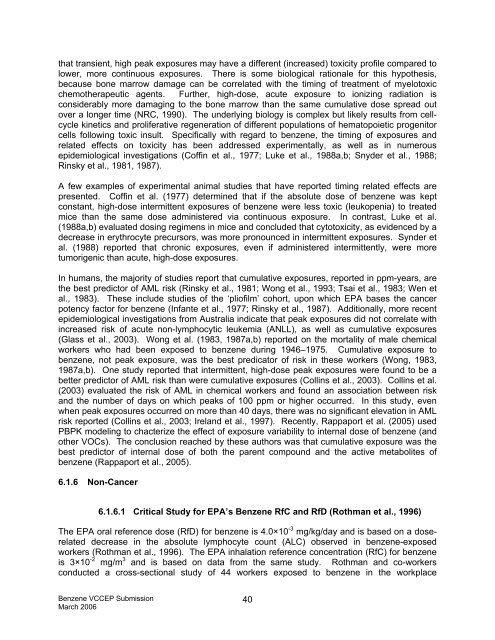(VCCEP) Tier 1 Pilot Submission for BENZENE - Tera
(VCCEP) Tier 1 Pilot Submission for BENZENE - Tera
(VCCEP) Tier 1 Pilot Submission for BENZENE - Tera
Create successful ePaper yourself
Turn your PDF publications into a flip-book with our unique Google optimized e-Paper software.
that transient, high peak exposures may have a different (increased) toxicity profile compared to<br />
lower, more continuous exposures. There is some biological rationale <strong>for</strong> this hypothesis,<br />
because bone marrow damage can be correlated with the timing of treatment of myelotoxic<br />
chemotherapeutic agents. Further, high-dose, acute exposure to ionizing radiation is<br />
considerably more damaging to the bone marrow than the same cumulative dose spread out<br />
over a longer time (NRC, 1990). The underlying biology is complex but likely results from cellcycle<br />
kinetics and proliferative regeneration of different populations of hematopoietic progenitor<br />
cells following toxic insult. Specifically with regard to benzene, the timing of exposures and<br />
related effects on toxicity has been addressed experimentally, as well as in numerous<br />
epidemiological investigations (Coffin et al., 1977; Luke et al., 1988a,b; Snyder et al., 1988;<br />
Rinsky et al., 1981, 1987).<br />
A few examples of experimental animal studies that have reported timing related effects are<br />
presented. Coffin et al. (1977) determined that if the absolute dose of benzene was kept<br />
constant, high-dose intermittent exposures of benzene were less toxic (leukopenia) to treated<br />
mice than the same dose administered via continuous exposure. In contrast, Luke et al.<br />
(1988a,b) evaluated dosing regimens in mice and concluded that cytotoxicity, as evidenced by a<br />
decrease in erythrocyte precursors, was more pronounced in intermittent exposures. Synder et<br />
al. (1988) reported that chronic exposures, even if administered intermittently, were more<br />
tumorigenic than acute, high-dose exposures.<br />
In humans, the majority of studies report that cumulative exposures, reported in ppm-years, are<br />
the best predictor of AML risk (Rinsky et al., 1981; Wong et al., 1993; Tsai et al., 1983; Wen et<br />
al., 1983). These include studies of the ‘pliofilm’ cohort, upon which EPA bases the cancer<br />
potency factor <strong>for</strong> benzene (Infante et al., 1977; Rinsky et al., 1987). Additionally, more recent<br />
epidemiological investigations from Australia indicate that peak exposures did not correlate with<br />
increased risk of acute non-lymphocytic leukemia (ANLL), as well as cumulative exposures<br />
(Glass et al., 2003). Wong et al. (1983, 1987a,b) reported on the mortality of male chemical<br />
workers who had been exposed to benzene during 1946–1975. Cumulative exposure to<br />
benzene, not peak exposure, was the best predicator of risk in these workers (Wong, 1983,<br />
1987a,b). One study reported that intermittent, high-dose peak exposures were found to be a<br />
better predictor of AML risk than were cumulative exposures (Collins et al., 2003). Collins et al.<br />
(2003) evaluated the risk of AML in chemical workers and found an association between risk<br />
and the number of days on which peaks of 100 ppm or higher occurred. In this study, even<br />
when peak exposures occurred on more than 40 days, there was no significant elevation in AML<br />
risk reported (Collins et al., 2003; Ireland et al., 1997). Recently, Rappaport et al. (2005) used<br />
PBPK modeling to chacterize the effect of exposure variability to internal dose of benzene (and<br />
other VOCs). The conclusion reached by these authors was that cumulative exposure was the<br />
best predictor of internal dose of both the parent compound and the active metabolites of<br />
benzene (Rappaport et al., 2005).<br />
6.1.6 Non-Cancer<br />
6.1.6.1 Critical Study <strong>for</strong> EPA’s Benzene RfC and RfD (Rothman et al., 1996)<br />
The EPA oral reference dose (RfD) <strong>for</strong> benzene is 4.0×10 -3 mg/kg/day and is based on a doserelated<br />
decrease in the absolute lymphocyte count (ALC) observed in benzene-exposed<br />
workers (Rothman et al., 1996). The EPA inhalation reference concentration (RfC) <strong>for</strong> benzene<br />
is 3×10 -2 mg/m 3 and is based on data from the same study. Rothman and co-workers<br />
conducted a cross-sectional study of 44 workers exposed to benzene in the workplace<br />
Benzene <strong>VCCEP</strong> <strong>Submission</strong><br />
March 2006<br />
40





